
|  |

|  |
The Rolls Royce and Indian Royalty - Shanta Serbjeet Singh e-mail: shanta.serbjeetsingh@gmail.com February 14, 2015 (This was featured as a preview of a focus on classic and vintage cars and other archival pieces by OSIANAMA, the art house, at Bombay's art deco Liberty Cinema.) The obsession of the royal families for expensive things and their crazy spending habits are funny stories for the present generation. Their fancy for big, expensive cars, too, is well known. Between 1907and 1947, around 900 Rolls-Royce cars made their way to India. Most of these cars have very interesting stories linked with them. Some of them are outrageous, others funny. Perhaps little known is the saga of how even an adornment of the maharaja’s stable, like a Rolls Royce, always the world’s most expensive car and the ultimate symbol of luxury, could be used by an Indian royal to humble the white man and teach him manners! 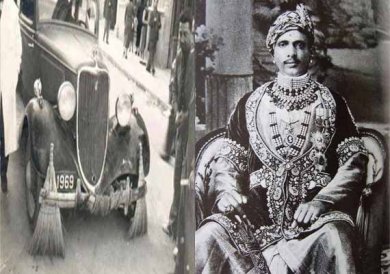 Rolls with jharoos from Alwar
The story is told about how the Maharaja Jai Singh of Alwar, a great aficionado of the Rolls, someone who always bought six of the latest at a time, happened to be in London. Dressed in casual Western clothes, he stepped into a Mayfair Rolls showroom and enquired the price of a model, the Phantom II Tourer. Predictably, he was taken for a poor Indian and shown the door, not too ceremoniously. Back in the hotel the Maharaja asked his staff to call the showroom and take an appointment in his name. On the appointed hour he visited the outlet, only, this time, to be greeted by a red carpet and liveried salesmen lined up with silver salvers to usher him. The Maharaja bought all the six Rolls in the showroom, paid for them in cash, including the handling and delivery charges. Back in Alwar, he ordered that the consignment be used by the city municipality for garbage collection! Soon the royals and other nobility of the then civilized world came to know of this huge insult to the great Rolls Royce brand and whenever someone talked about buying a new Rolls, it was greeted in the salons of the rich by a huge guffaw and the snide remark, “Which one? Hope it is not the one the Indian maharaja uses for garbage collection in his home town?” Falling sales so alarmed the Rolls top brass that finally they sent an abject apology to Maharaja Jai Singh and sent him, as gift, six brand new Rolls Royce for his personal use. The point having been made, the Maharaja relented and withdrew the fleet being used for garbage disposal. According to Baig, however, the present-day Maharaja of Alwar, Jeetender Singh told him "That incident was burnt into the collective family memory," adding "We were perhaps the only royal family that was allowed to buy any car except a Rolls-Royce. We have numerous vintage cars but not a single Rolls." In his book ‘Rolls-Royce and the Indian Princes’ published by Roli Books in New Delhi, motoring writer Murad Ali Baig recounts that 1,000 Rolls-Royces were built before the First World War and about 20 per cent of them were for India; it has been estimated that, on average, each maharaja had between 3 and 5 Rolls. Since there were about 230 maharajas (excluding the minor ones), that means about 900 cars between 1908 and 1939. Baig adds other memorabilia about how the Rolls-Royce satisfied every conceivable whim in the customization and finishing touches that each patron wanted. It hardly had a choice, really, because after extravagance, the next most prominent trait of the maharajas was eccentricity. The Maharaja of Jamnagar, for example, sent the company one of his wife’s pink slippers to ensure that his Phantom II was painted in exactly the right hue. Many maharajas preferred cabriolet versions that enabled them to sit on a raised seat in the rear of the automobile, so that their subjects could see them easily and pay homage. Some opted for the "purdah" model with thick curtains on the windows to protect the royal ladies from male stares. Sometimes, though, it was servants who needed to be invisible. “A 1933 Rolls-Royce 20/30, Sedanca de Ville that belonged to Maharani Sethu Parvati Bai of Travancore had a small stool on the floor. On it sat a dwarf who massaged the queen’s legs,” writes Baig. The current Maharaja of Udaipur, Arvind Mewar, recalls that his grandfather, being handicapped, asked the company to put the controls in the steering wheel so that he could drive more easily. “There was just no other car that could match the Rolls. In the 1940s, we had about 10 of them. I know it sounds decadent but, as a child, travelling in these cars was a routine affair.” In 1913, a grand Silver Ghost was bought by His Highness the Nizam of Hyderabad, one of the richest men in the world but a notorious eccentric and miser. The handbook stated that it was a "semi-state coach." It was indeed a sort of throne car, painted in a rich canary yellow with gold mountings and upholstered in gold silk brocade with matching curtains. This was only one of the Nizam's 50 Rolls-Royces, as befitting a man who employed 12,000 servants in his palace, including 38 to dust the chandeliers and others merely to grind walnuts. Yet he wore the same greasy fez for 30 years. On occasions when he invited people for tea, a Rolls decked out in feudal finery and with a cocktail bar in the back would go to pick them up. His fleet had barely covered 1,000 miles when he died in 1967. Easily Rolls-Royce's favourite customer was the Maharaja of Mysore, because he always bought cars in batches of seven. According to the Rolls-Royce archives, the phrase "doing a Mysore" passed into company parlance to mean selling seven cars at once. Undivided Punjab’s very colourful Maharaja Bhupinder Singh was the first man in India to own an aircraft, which he bought from the United Kingdom in the first decade of the twentieth century. For his aircraft he had the first airstrip built at Patiala, his capital. His taste in cars too was extravagant and legend has it that Maharaja Bhupinder Singh would be driven in a motorcade of 20 Rolls Royce. The other prince of Punjab, the Maharaja of Nabha, built a swan at the head of his car. When the Maharaja would set out for his evening drive through the town, the sight of the swan, seemingly drinking water would thrill the local populace. 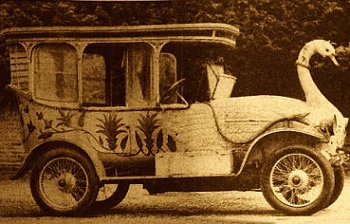 Swan Rolls Royce 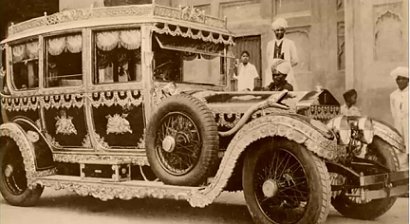 Rolls palace on wheels 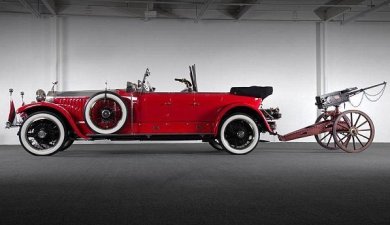 Rolls with hunting rifle 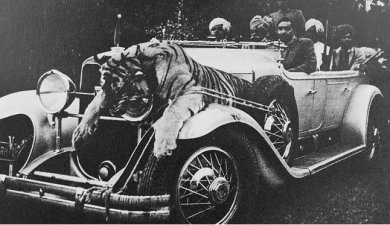 Rolls for tiger hunting Tiger hunting was a passion with the maharajas but they did not believe in roughing it in the jungle. The royal style was carpeted tents, cases of Fortnum & Mason goodies, champagne and a battalion of cooks rustling up five-course meals in a mud kitchen. It was only natural, therefore, that Rolls-Royces became an important accessory. Specially fitted cars had extra footboards for the servants to stand on while the car rushed through the forest and special high-beam lamps to dazzle the tiger. Some were fitted with bells to fool the big cat into thinking a herd of cattle was approaching. A beauty, now in a European museum, even had an elephant rifle and trailing behind the car, a machine gun! Baig says he believes there are now about 169 Rolls-Royces remaining in India, a few in museums - Arvind Mewar, for example, has a small museum in Udaipur - but most in the hands of private collectors. Some were sold to foreign collectors until their export was banned. Mumbai-based Pranlal Bhogilal is believed to have the largest number - about 65 in his collection of some 200 cars. Mr. Bhogilal and Mr. Mewar love restoring vintage Rolls-Royces but before the 1960s, when people began to realise their value, many specimens lay around like scrap. One, in Lucknow, had its back cut off for use as a delivery truck. Another, a 1919 Phantom I, lay rotting in the Vijayanagram palace stables with a tree growing through its floorboards. "But even after 60 years, most engines would start up effortlessly," says Mr. Mewar. "Can you say that about any other car?"  Shanta Serbjeet Singh, for twenty-five years, columnist, critic and media analyst for The Hindustan Times, The Economic Times and The Times of India, is the recipient of the Lifetime Achievement Award of the Sangeet Natak Akademi and Delhi Govt.'s Sahitya Kala Parishad for her contribution to the field of culture. She just finished her term as Vice Chairman of the SNA, is the founder-secretary of the World Culture Forum and continues as Chair of the UNESCO created NGO APPAN (The Asia-Pacific Performing Arts Network), a position to which she was appointed in 2001. Singh has authored several well-known publications such as 'Indian Dance: The Ultimate Metaphor' (published by Ravi Kumar (Paris), 'The 50th Milestone: A Feminine Critique' (Sterling Publishers, to mark India's fiftieth anniversary of Independence), 'Nanak, The Guru' (Oxford University Press) and 'America and You' (22 editions). Post your comments Pl provide your name and email id along with your comment. All appropriate comments posted with name and email id in the blog will also be featured in the site. |